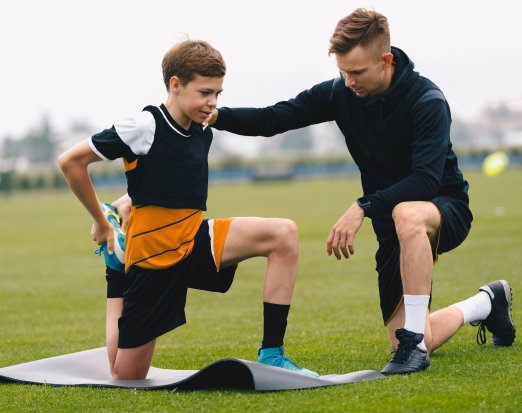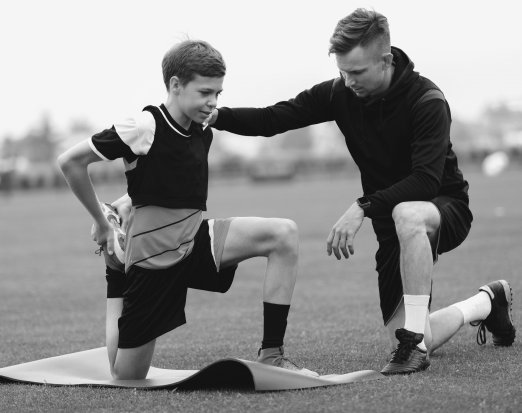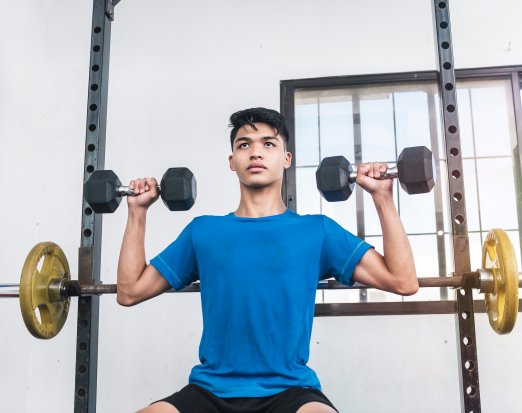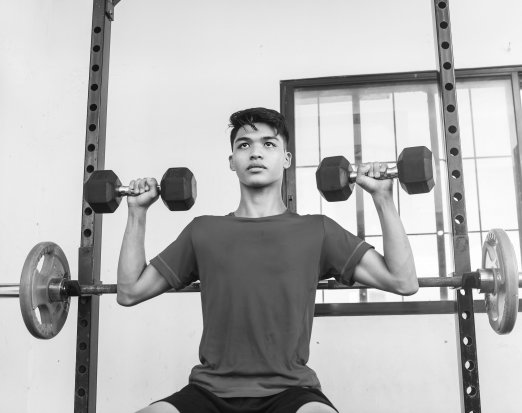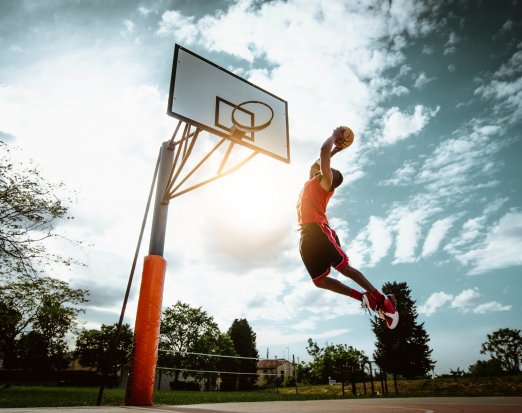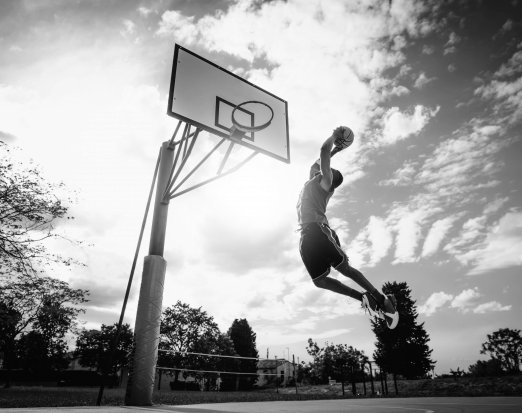Team Sports - Repeat Sprint Ability
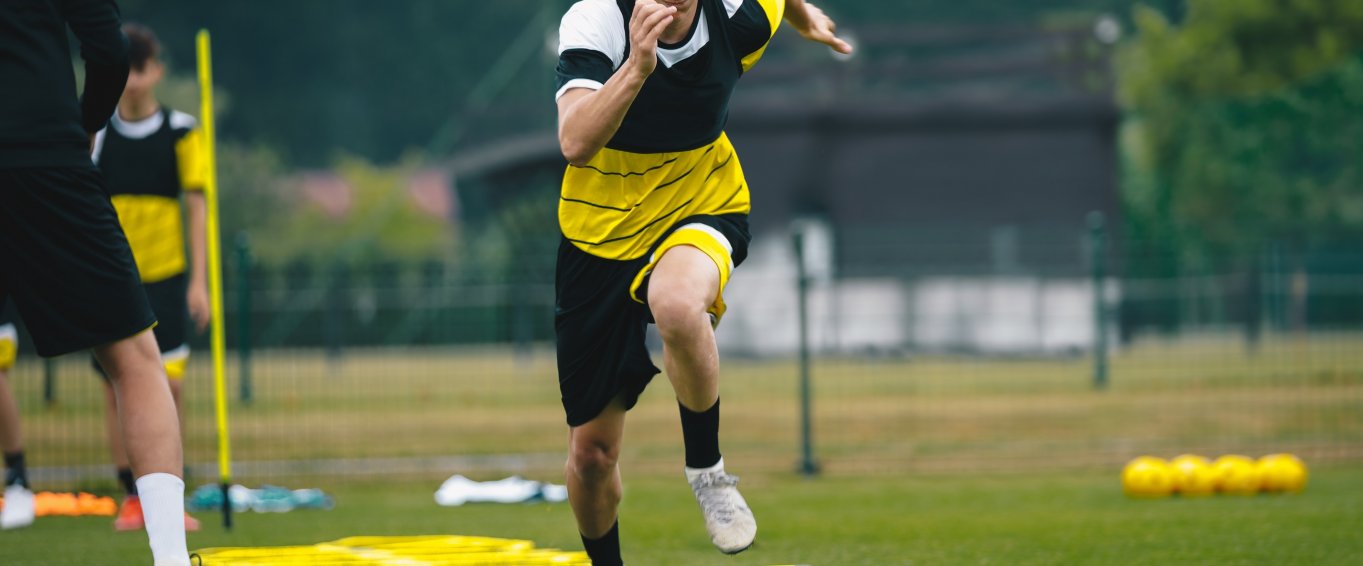
Team sports are played over a set time, football – 90 minutes, netball – 60 minutes, rugby – 80 minutes. Even though the games are played intermittently, interval -stop-start, and the games have regular breaks, it is generally believed that the players require a high level of endurance or aerobic fitness for on field performances. Aerobic capacity is frequently measured in laboratory settings or as a projection in field-based settings (for example, multi-staged shuttle run) and expressed as the athlete’s VO2 max. the below table gives some references of aerobic capacity from a range of team sports – recreational to elite players.
| Athlete/Sport | VO2 (ml.kg/min) |
| Recreational male football players | 55.7 |
| Academy male football players | 56.5 |
| Edwards et al 2003 (4) | |
| Under 17's female football players | 58.4 |
| Under 21's female football players | 59.4 |
| Professional female football players | 57.9 |
| Papaevangelou et al 2012 (14) | |
| Junior male rugby league players | 50.3 |
| Senior male rugby league players | 47.2 |
| Gabbet 2006 (5) | |
| State-level female netball players | 57.7 |
| Graham et al 2019 (9) |
The above tables show that team sport athletes tend to have a high aerobic capacity, however, interestingly there is not much difference between recreational players to state players to even elite players. This does not mean that aerobic fitness is not important but seems to suggest that there might be an optimal aerobic level relative to the sporting demand – and other fitness components maybe more important as players progress through the ranks. Additionally, as previously mentioned, as team-sports are played in an interval-stop-start method, with frequent short sprints under ~10m with incomplete rest periods, having the ability to sustain high average sprint speeds without suffering from fatigue will clearly be an advantage.
Using time-motion analysis, studies have shown that the average sprint distance in team sports range between 10 – 20 metres or 2 – 3 seconds (17). In football, for example, where professional footballers performed on average 11-sprints per game, with 90% of the sprints under 5 seconds (1), and in rugby with 39.7% of sprints were between 6 -10 metres (6). Even though that sprinting in team sports contributes to ~10% of distance covered, it generally is the most important parts of the game, which potentially influences the game result (9).
As we start to understand that team-sports are played in an interval-type method, and sprint ability is a predictor of performance, more focus has turned to repeat sprint ability. Repeat sprint ability is defined as the capability to perform multiple sprints, under 10 seconds, with incomplete recovery, under 60 seconds (7). Players or athletes that can sustain a higher average sprint speed with less fatigue, will clearly have an advantage over their opponent. Repeat sprint ability should not be confused with intermittent-interval, or intermittent- sprint training, as intermittent-sprint type training allows for longer or full recovery between sprint efforts. Allowing athletes to have longer recovery periods between sprints, even moving towards full recovery has been shown to have less impact on fatigue and on sprint times (2).
With more attention placed on repeat sprint ability, especially for team-sports, or any sports that require short sprints interspersed with incomplete recovery, an interest or questions have arisen on effective training strategies to improve this important fitness component. As repeat sprint ability is extremely complex due to the key factors – sprinting and fatigue, it makes the prescription of one training modality virtually impossible, however, two lines of thoughts have remained in the literature – the training of repeat sprints (task specific) and to understand the different factors that contribute to repeat sprint ability (physiological, aerobic capacity, energy pathways, buffering of by-products, neural factors, muscle coordination, RFD, and tendon adaptations).
Factors and Training to Develop Repeat Sprint Ability
There are many factors or components linked to improving repeat sprint ability, and therefore, it is difficult to prescribe one mode of training or even state which mode is more important. To help solve this, the literature does give some guidance and training suggestions. To further help with practical application, the training can be categorised into physiological and neural components.
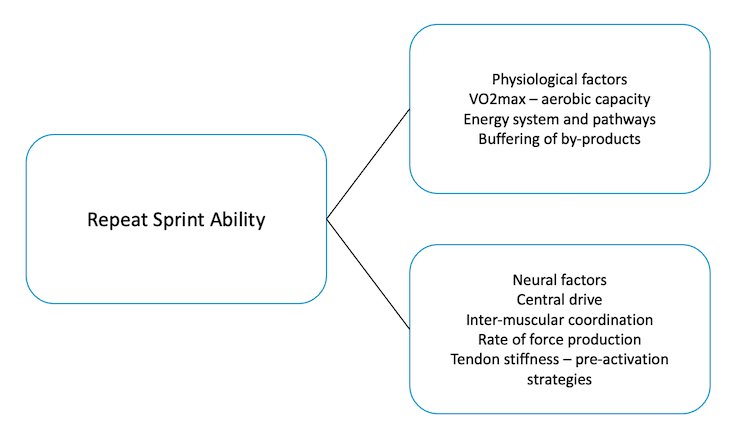
Physiological Factors
To be classified as repeat sprint ability, a series of sprints (10 seconds) are interspersed with short or incomplete rest periods (<60 seconds). This places a high demand on the energy systems to resynthesise ATP to allow for the next sprint effort. As full recovery is not achieved the anaerobic system will be a major contributor (especially as more sprints are completed), with the consequence of by-products. An increase in by-products (H+) (21), may influence sprint performances, via accumulation of fatigue and/or interfere with force production (20). As inter-recovery-sprint rates are an important factor in repeat sprint ability, it is believed that a high aerobic capacity will help resynthesise ATP and buffer by-products (3).
Neural Factors
Acceleration and sprint performance are highly linked with neuromuscular function, including, central drive, force production, contraction speed, muscle recruitment strategies, tendon stiffness and coactivation (15). Fatigue seems to alter neural function and therefore sprint performances. A ~10% fatigue in sprint times using the fatigue index percentage, a small decline might manifest, however, greater than ~10% a large decline in sprint performances have been reported (12). Furthermore, repeated sprint and fatigue may change or alter mechanical stiffness (15), with the idea that a stiffer system helps with both rate of force development and potentially elastic energy (13). As from previous blogs on strength training, plyometric training, and power training. By frequently performing these modes of training, either independently or as a combination, this will clearly enhance neuromuscular function and aid in sprint performances (10).
Testing of Repeat Sprint Ability
It is important to stress that repeat sprint ability consists of two main factors – sprint performance – sometimes referred to as the sum of the sprints, or mean sprint times. Secondly, the decrement or decline in sprint times from the onset of fatigue. This is central to understand, for example, an athlete’s sprint times might be relatively slow, but due to their ability to recover well, their repeat sprint ability or Fatigue Index will be excellent. Conversely, another athlete might have a great first sprint time, but due to this excellent first sprint time compared to their last sprint time suggests that their ability to recover is poor – caution is required, when assessing the athlete’s repeat sprint ability, with literature suggesting that – the average sprint times = sprint performance, and the decrement of sprint times (relative to the athlete’s best or optimal sprint time) = fatigue. This helps to support and offer training to each athlete relative to their needs and performance.
As described above, there are challenges when trying to test the athlete’s repeat sprint ability. Generally, the tests fall into two camps. The Fatigue Index Percentage, which looks at the athlete’s first sprint and their last sprint. By dividing their last sprint time by their first sprint time, this will give a percentage of drop-off – with the idea that less of a drop-off between the first and last sprint time indicates a better repeat sprint ability. There’s been opponents to using this type of repeat sprint ability test, however, as the calculation only looks at the athlete’s first and last sprint time and doesn’t look at the mean sprint times. The Sprint Decrement Percentage Score considers most or all the sprint times rather than the fastest and slowest. By looking at more of the sprint times, this gives a better picture of how the athlete is performing – remember – average sprint times = sprint performance. Decrement or drop off rates in sprint times = accumulation of fatigue.
Training Methods
With so many factors to repeat sprint ability, it will be impossible for athletes to complete or perform all the training modes, therefore, it is important that athletes are constantly monitored. By monitoring the athletes training modes can be prescribed or suggested that may help with a specific factor in their repeat sprint ability.
| Training Type | Training Adaptations to Help with Repeat Sprint Ability |
| Interval Training | Can help with recovery rates and buffer capacity. |
| Continuous Training | Improvements in VO2 max - aerobic capacity. |
| Repeat Sprint - incomplete recovery | Improvements in VO2 and sprint training practice. Task specific training. |
| Strength and Power Training | Neuromuscular adaptations to enhance force production - Rate of force development. Tendon stiffness. |
| Plyometrics | Neuromuscular adaptations to ehance the stretch-shortening cycle. Reactive strength and reduced ground contact times. |
| Sprints - full recovery | Neural factors - central drive, neuromuscular function. Task specific training. |
Youth Development and Considerations with Repeat Sprint Ability
There are some considerations for youth athletes, pre and post peak height velocity. As youth athletes, pre-peak height velocity, there doesn’t seem to be a differentiation between sprinting and endurance, in other words, young players that sprint well may also have a high endurance capacity (11). This tends to be the case until the athletes go through maturation – post peak height velocity, and their profiles start to change (16). This was also shown in a study that compared repeat-sprint ability to other performance characteristics (aerobic fitness, explosive leg power, acceleration, and agility) in different age-groups. The results highlighted that repeat-sprint ability was less correlated with other fitness components in younger-athletes (probably due to coordination levels), however, the correlations stabilised and became stronger with older-athletes, especially acceleration and agility (19).
Just like senior athletes repeat sprint ability in adolescent athletes is multifactorial, where the athletes will need different modes of training to help with performance characteristics. From a practical application, we can refer to the above table, as this is aligned with a well-rounded strength and conditioning programme and long-term athlete development framework, which will develop the athlete and provide the athlete with the physical components. Furthermore, as there are numerous training methods to choose from this again highlights’ the importance of monitoring the athlete’s physical qualities so that effective training strategies can be suggested and prescribed.
As a closing point on youth training and team sports is on the prescription of aerobic training through continuous or long-slow training method. For youth athletes, I would suggest exposing young athletes to regular sprint - interval and repeat sprint training (incomplete and full recovery), along with their regular strength and plyometric training. Long-slow distance training will bring some benefits; however, the improvements are inconsistent, especially in young athletes (pre-PHV) (22).
Summary
The ability to perform repeated sprints, under 10 metres with short or incomplete rest periods has been termed – repeat sprint ability, and is an essential fitness component, especially for team sports. As team sports are played in an interval-type mode, repeat sprint ability has gained more attention since the number of sprints or the average sprint speed influences game results. This has led to training ideas and what methods will help with improving repeat sprint ability. Generally, two lines of thoughts are discussed, a) training of repeated sprints – task specific qualities, and b) other fitness components that contribute to improvements, including physiological factors - aerobic capacity, energy pathways, buffering of by-products, and neural factors – higher central drive, inter-muscular coordination, rate of force development, and tendon stiffness.
As there are many factors to improving repeat sprint ability, it is important to both tests and track athletes and their physical developments and improvements. Through regular athlete testing this will help coaches in their prescription of training modes, for example – strength training for relative strength, plyometrics for reactive strength or for the stretch-shortening cycle to cope with high forces. Repeat-interval sprint training to aid in aerobic capacity and/or to help with buffering of by-products (reduce fatigue or improved recovery).
For young athletes, other fitness components seem to be less correlated with repeat sprint ability, probably due to coordination factors (the system is still learning for example - sprint qualities), and therefore, a general training approach can be applied – strength training, plyometrics and regular sprint exposure. However, as the athletes mature (post-peak height velocity), it is again, essential to track and monitor the athletes, so that specific modes of training can be prescribed helping with long-term improvements and sporting performances.
Youth Strength & Conditioning Platform for Schools, Sport Clubs, and Academies.
Our platform helps to deliver effective training and tracks athletic progress and development, with the core objectives of reducing the risk of injuries and to promote both sport readiness and performance. The platform’s features include
- Strength and conditioning tests and dashboard to monitor and compare athlete metrics
- Athlete app - athletes can discover new exercises and train independently
- Track data - monitor athlete’s training loads, RPE, and training adherence
- Reports - simply create squad, team, and individual athlete reports
- Full curriculum - follow a strength and conditioning curriculum with a library of session plans
References
- Andrzejewski, M., Chmura, J., Pluta, B., Strzelczyk, R., & Kasprzak, A (2013). Analysis of sprinting activities of professional soccer players. Journal of Strength & Conditioning Research, 27(8), 2134 – 2140.
- Balsom, P.D., Segar, J.Y., Sjodin, B., & Ekblom, B. (1992). Physiological response to maximal intensity intermittent exercise. European Journal of Applied Physiology, 65, 144 – 149.
- Buchheit, M., & Ufland, P. (2010). Effect of endurance training on performance and muscle reoxygenation rate during repeated-sprint running. Eur J Appl Physio, 111, 293 – 301.
- Edwards, A.M., Macfadyen, A.M., & Clark, N. (2003). Test performance indicators from a single soccer specific fitness test differentiate between highly trained and recreationally active soccer players. J Sports Med Phys Fitness, 43, 14 – 20.
- Gabbett, T.J. (2006). Performance changes following a field conditioning progam in junior and senior rugby league players. Journal of Strength and Conditioning Research, 20(1), 215 – 221.
- Gabbett, T.J. (2012). Sprinting patters of national rugby league competition. Journal of Strength & Conditioning Research, 26(1), 121 – 130.
- Girard, O., Mendez-Villanueva, A., Bishop, D. (2011). Repeated-sprint ability – Part 1. Sports Medicine, 41(8), 673 – 694.
- Graham, S., Duthie, G., Aughey, R., & Zois, J. (2019). Comparison of physical profiles of state-level netball players by position. Journal of Strength and Conditioning Research, 34(9), 2654 - 2662.
- Kaplan, T. (2010). Examination of repeated sprinting ability and fatigue index of soccer players according to their positions. Journal of Strength & Conditioning Research, 24(6), 1495 – 1501.
- Kobal, R., Loturco, I., Barroso, R., Gil, S., Cuniyochi, R., Ugrinowitsch, C., Roschel, H., & Tricoli, V. (2017). Effects of different combinations of strength, power, and plyometric training on the physical performance of elite young soccer players. Journal of Strength and Conditioning Research, 31(6), 1468 - 1476.
- Mendez-Villanueva, A., Buchheit, M., Kuitunem, S., Poon, T.K., Simpson, B., & Peltola, E. (2010). Is the relationship between sprinting and maximal aerobic speeds in youth soccer players affected by maturation. Paediatric Exercise Science, 22, 497 – 510.
- Mendez-Villanueva, A., Hamer, P., & Bishop, D. (2008). Fatigue in repeated-sprint exercise is related to muscle power factors and reduced neuromuscular activity. European Journal of Applied Physiology, 103, 411 – 419.
- Myers, R.W., Moeskops, S., Oliver, J.L., Hughes, M.G., Cronin, J.B., & Lloyd, R.S. ( 2019). Lower-limb stiffness and maximal sprint speed in 11-16-year-old-boys. Journal of Strength & Conditioning Research, 33(7), 1987 – 1995.
- Papaevangelou, E., Metaxas, T., Riganas, C., Mandroukas, A., & Vamvakoudis, E. (2012). Evaluation of soccer performances in professional, semi-professional and amateur players at the same club. Journal of Physical Education and Sport, 12(3), 362 – 370.
- Ross, A., Leveritt, M., & Riek, S. (2001). Neural influences on sprint running: training adaptations and acute responses. Sports Medicine, 31(6), 409 – 425.
- Selmi, M.A., Al-Haddabi, B., Haj, Yahmed, M.H., Sassi, R.H. (2017). Does maturity status affect the relationship between anaerobic speed reserve and multiple sprint sets performance in young soccer players. Journal of Strength & Conditioning Research, 000, 1 -7.
- Spencer, M., Bishop, D., Dawson, B., & Goodman, C. (2005). Physiological and metabolic responses of repeated-sprint activities; specific to field-based team sports. Sports Med, 35(12), 1025 – 1044.
- Spencer, M., Lawrence, S., Rechichi, C., Bishop, D., Dawson, B., & Goodman, C. (2004). Time-motion analysis of elite field hockey, with special reference to repeat sprint ability. Journal of Sports Sciences, 22, 843 – 850.
- Spencer, M., Pyne, D., Santisteban, J., & Mujika, I. (2011). Fitness determinants of repeated-sprint ability in highly trained youth football players. International Journal of Sports Physiology and Performance, 6, 497 – 508.
- Spriet, L.L., Lindinger, M.I., Mckelvie, R.S., Heigenhauser, F., & Jones, N.L. (1989). Muscle glycogenolysis and H+ concentration during maximal intermittent cycling. J Appl Physiol, 66(1), 8 – 13.
- Turner, A.N., & Stewart, P.F. (2013). Repeat sprint ability. Strength and Conditioning Journal, 35(1), 37 – 41.
- Welsman, J., Armstrong, N., & Withers, S. (1997). Responses of young girls to two modes of aerobic training. Br J Sports Med, 31, 139 – 142.
